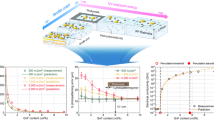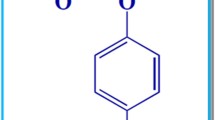Abstract
We present the preparation and electrical characterization of an electrically conductive blend of polyaniline (PANi) and SU-8 UV micropatternable photoresist that offers promising opportunities for MEMS applications. The blend was prepared by shear mixing of PANi and SU-8 2010 resist at an rpm of 1,000 for 15 h. The composite was spin-coated on a silicon wafer at an 850 rpm in order to achieve a thickness of 50 µm, followed by soft baking at 70 °C for 35 min and cooling to room temperature. The desired structures were patterned using masked UV exposure for 60 s. Full cross-linking of PANi and SU-8 blend was achieved by a post-exposure bake at a temperature of 90 °C for 25 min, followed by cooling to room temperature. The desired electrode structures and trace lines were then developed in SU-8 developer for 10 min by manual agitation. The fabricated structures were characterized under Scanning Electron Microscope and through Electron Dispersion X-ray Spectroscopy (EDS) demonstrating that good patternability was achieved when using photo-initiator (triarylsulfonium hexafluoro-anitimonate salts) and gamma-butyrolactone solvents in the blend. Further, electrical characterization together with EDS showed that an electrically conductive path is formed in the PANI SU-8 2010 polymer matrix. It is also observed that resistivity as low as 350 Ω-m was achieved at 8.6 wt% of PANi in SU-8 2010 polymer matrix.








Similar content being viewed by others
References
Ates M, Karazehir T, Sarac AS (2012) Conducting polymers and their applications. Development 51:52
Burroughes JH, Bradley DDC, Brown AR, Marks RN, MacKay K, Friend RH, Burns PL, Holmes AB (1990) Light-emitting diodes based on conjugated polymers. Nature 347(6293):539
Cheng JH, Fou AF, Rubner MF (1994) Molecular self-assembly of conducting polymers. Thin Solid Films 244(1):985–989
Fengling Z, Johansson M, Andersson MR, Hummelen JC, Inganäs O (2002) Polymer photovoltaic cells with conducting polymer anodes. Adv Mater 14(9):662–665
Garnier F (1989) Functionalized conducting polymers—towards intelligent materials. Angew Chem Int Editi Engl 28(4):513–517
Gerard M, Chaubey A, Malhotra BD (2002) Application of conducting polymers to biosensors. Biosens Bioelectron 17(5):345–359
Gustafsson G, Cao Y, Treacy GM, Klavetter F, Colaneri N, Heeger AJ (1992) Flexible light-emitting diodes made from soluble conducting polymers. Nature 357(6378):477–479
Heeger AJ, Schrieffer JR, Su W-P, Su W (1988) Solitons in conducting polymers. Rev Mod Phys 60(3):781
Hesketh PJ, Misra D, Takamatsu S, Itoh T, Khosla A, Saheb AH, Leon M, Josowicz M (2012) Conducting polymers and their applications. Interface Electrochem Soc 21(3):61
Kassegne S, Wondimu B, Majzoub M, Shin J (2008) High-efficiency microarray of 3-D carbon MEMS electrodes for pathogen detection systems. International Symposium on Optomechatronic Technologies, 726615–726616
Kassegne S, Mehta B, Khosla A (2014) Manufacturing of high aspectratio 3-dimensional PolyFerroCNT nanocomposite polymer electrodes. Microsyst Technol. doi:10.1007/s00542-014-2250-4. Springer, Berlin
Khosla A (2011) Micropatternable multi-functional nanocomposite polymers for flexible soft MEMS applications. PhD Thesis. http://summit.sfu.ca/item/12017
Khosla A, Gray BL (2009) Preparation, characterization and micromolding of multiwalled carbon nanotube polydimethylsiloxane conducting nanocomposite polymer. Mater Lett 63(13):1203–1206. doi:10.1016/j.matlet.2009.02.043
Khosla A, Gray BL (2012) (Invited) “Micropatternable multifunctional nanocomposite polymers for flexible soft NEMS and MEMS applications. ECS Trans 45(3):477–494. doi:10.1149/1.3700913
MacDiarmid AG (1997) Polyaniline and polypyrrole: where are we headed? Synth Met 84(1):27–34
MacDiarmid AG et al (1987) Polyaniline: a new concept in conducting polymers. Synth Met 18(1):285–290
Patel CV, Khosla A, Kassegne S (2013) Micropatternable, electrically conducting polyaniline photoresist blends for mems applications. ECS Trans 50(12):525–535. doi:10.1149/05012.0525ecst
Sariciftci NS, Smilowitz L, Heeger AJ, Wudl F (1992) Photoinduced electron transfer from a conducting polymer to buckminster fullerene. Science 258(5087):1474–1476
Skotheim TA (1986) Handbook of conducting polymers, vol 2. Marcel Dekker, New York
Snook GA, Kao P, Best AS (2011) Conducting-polymer-based super-capacitor devices and electrodes. J Power Sources 196(1):1–12
Syed AA, Dinesan MK (1991) Review: polyaniline—a novel polymeric material. Talanta 38(8):815–837
TEJSKAL JS (2006) Polyaniline preparation of a conducting polymer, (IUPAC Technical Report) Prepared for publication Institute of Macromolecular Chemistry, Academy of sciences of the Czech Republic, 162 06, Prague 6, Czech Republic in collabration with R.G.GILBERT Key centre for Polymer Colloids-F11, University of Sydney, NSW, Australia
Vahidi N, Hirabayashi M, Mehta B, Khosla A, Kassegne S (2014) Bionanoelectronics platform with DNA molecular wires attached to high aspect-ratio 3D metal microelectrodes. ECS J Solid State Sci Technol 3(3):Q29–Q36
Xia Y, Zhao X-M, Whitesides GM (1996) Pattern transfer: self-assembled monolayers as ultrathin resists. Microelectron Eng 32:255–268
Wang C, Taherabadi L, Jia G, Kassegne S, Zoval J, Madou M (2004) Carbon-MEMS architectures for 3D microbatteries, Photonics Europe, 295–302
Acknowledgments
Authors would like to acknowledge San Diego State University Electron Microscope facilities and Dr. Steve Barlow for allowing us access to the SEM for our EDS analysis.
Author information
Authors and Affiliations
Corresponding author
Rights and permissions
About this article
Cite this article
Khosla, A., Patel, C. Microfabrication and characterization of UV micropatternable, electrically conducting polyaniline photoresist blends for MEMS applications. Microsyst Technol 22, 371–378 (2016). https://doi.org/10.1007/s00542-015-2418-6
Received:
Accepted:
Published:
Issue Date:
DOI: https://doi.org/10.1007/s00542-015-2418-6




